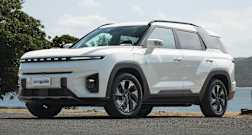Kia Australia has been a bit slower on electrification than its Hyundai sister brand, but the Niro small SUV looks to make up for the delay with an all-in-one electrification solution.
You can choose it in hybrid, plug-in hybrid, or fully electric forms, and size-wise it slots oh-so-neatly into the brand’s line-up between the smaller Stonic and larger Seltos.
It offers something which many brands thus far have struggled with. A mainstream shape and design with all the benefits of the electric drivetrain of your choice. Plus, the fully electric version we’re looking at for this review shares its underpinnings with the relatively successful Hyundai Kona Electric.
Sounds promising. But can this electric small SUV take a place up there with the best electric options in Australia? To find out, I took a top-spec Sport for a week.
Kia Niro 2021: Electric Sport
| Engine Type | Not Applicable, 0.0L |
|---|---|
| Fuel Type | Electric |
| Fuel Efficiency | 0.0L/100km (combined) |
| Seating | 5 |
| Price From | $28,710 - $34,540 |
Price and features - Does it represent good value for the price? What features does it come with?
First up there’s something you should know about the Kia Niro. It’s not new. At least, not globally. You see, the Niro has been around in other markets as long as its Hyundai Kona relation, dating way back to 2016, and even the electric version has been available in its Korean home market since 2018.
.jpg)
The car which arrives here is a 2020 facelift of a car which is now five years old, and there are areas in which you can tell. The most obvious giveaway is the lack of the new Kia badge on this car’s nose or steering wheel, but it’s reflected on the spec sheet in less than impressive areas.
Wearing an MSRP of a whopping $70,990, the Niro EV is by no means cheap either as a small SUV or as an electric car. Even the freshly facelifted Hyundai Kona Electric ($66,000) comes in nearly $5000 less in its most expensive form, and in this spec the Niro is even more expensive than its key Tesla Model 3 rival, which offers comparative range and amazing technology.
Frustratingly, the standard equipment is also lower than the Kona Electric, with the Niro lacking things like a wireless phone charger, holographic display, heated seats, or a fully customisable digital dash cluster.
.jpg)
This is important for an electric car, too, because heated seats are more than just a luxury; they are an energy efficient way of warming up the car’s occupants. The Kona Electric not only gets them for the front seat, but in the rear seats, too! To add insult to injury, the EV only gets single-zone climate control.
It’s not all bad news though, as elsewhere there’s some decent stuff. I like the fully integrated 10.25-inch multimedia screen, which comes complete with sat nav, digital radio, and the expected phone connectivity (even if it is wired instead of wireless), and while the digital dashboard isn’t as sleek and customisable as the Hyundai unit, it looks neat.
Elsewhere the Niro EV Sport scores an eight-speaker premium audio system, keyless entry and push-start ignition, 17-inch ‘aerodynamic’ alloy wheels clad in Michelin Primacy 3 tyres, synthetic leather interior trim, LED headlights with auto high beams, and an auto dimming rear vision mirror.
.jpg)
The safety suite is decent, too, and will be looked at later in this review. So, on the value front it’s not great. You get everything a modern car needs, but it’s puzzling there are some major omissions compared to the more affordable and longer-range Kona Electric.
Design - Is there anything interesting about its design?
The Niro is iconic Kia for better or worse. On the upside, it’s familiar and definitely approachable, the very visage of a commuter small SUV, arriving to Australia so late in its lifecycle comes with some downsides though.
.jpg)
Firstly, it’s missing the brand’s latest branding; secondly the interior just feels dated for an electric car. The large screen is nice in this top-spec Sport, but the steering wheel which looks like it could be shared with a 2015 Sportage is looking alarmingly dated. The same goes for the interior plastics and switchgear, which seem to fly in the face of this car’s unconventional cockpit design.
Old bits or not, from the cockpit this car manages to communicate a futuristic feeling. Unlike the Kona – which nestles you in with its floating dash and improved soft-touch finishes – the Niro has you floating in an open space with a glasshouse view of the road and a full removal of the centre console from the hybrid versions. The materials aren’t quite as good as some rivals, but it feels right for an EV to have all the extra space.
From the outside I think the Niro is certainly more coherent in its approach than the wily new Kona. It has a more consistent face across its range, and a more toned-down design which doesn’t outwardly yell about its futuristic underpinnings. I think it presents a less extreme alternative to the Kona Electric, and while I liked the electric version, there are definitely areas where the Niro has executed things better. The charging port at the front of the car is more seamlessly integrated into the Niro’s design, for example, and I appreciate the consistency which has evolved in the brand’s range.
.jpg)
If the incoming EV6 is anything to go by, don’t expect this design consistency to last. The brand has made no illusions about its plans to move away from these Schreyer designs in the near future.
Practicality - How practical is the space inside?
In this EV version of the Niro, Kia has leaned into its electric underpinnings to grant more space, and there are some surprises here too.
As already mentioned, the cabin for front passengers is highly adjustable, and the amount of window room on offer and the high seating position conspire for excellent visibility out of this little SUV. Storage options are great, with large bottle holders and pockets in the doors, a huge scooped out section of centre console which goes all the way to the floor (and so suitable for even large objects), and an odd-looking floating console with big dual cupholders, the rotary shifter, and a centre armrest box.
.jpg)
Just like other Kia models, there’s the same dial-operated climate unit sitting above a shelf tailor-made for phones, which also hosts the dual USB and single 12V outlet. Nice.
The rear seat was a huge surprise, because only weeks prior I was reminded of how cramped this space is in the Kona Electric. Through some trick of design, however, Kia has managed to make this space gigantic in the related Niro EV. I felt like I had leagues of knee room behind my own driving position, as well as plenty of head and legroom, in stark contrast to this car’s Kona relation. This is without a doubt the choice of the two when it comes to ferrying around adult passengers in comfort.
.jpg)
Amenities in the rear seat are great too, with a drop-down armrest with dual cupholders, single large bottle holders in the doors, a netting on the back of the front passenger seat, and dual adjustable air vents with a lock-off. Sadly though, rear passengers miss out on power outlets. This is particularly odd, as the Kona Electric gets a single USB outlet but no adjustable vents.
.jpg)
Then there’s the boot, which again flips the script on its head. While you might imagine the EV gets the smallest boot with its abundance of battery capacity, it’s quite the opposite in this case. Not only does the EV version get the largest boot capacity of the Niro range at 451 litres (VDA), but it’s over 100 litres larger than the Kona Electric, which has a meagre 332L on offer. For context, the Kona could only just fit our CarsGuide luggage set, while the Niro was able to easily consume it with space to spare.
Under the floor in the Niro there is a surprisingly large space which hosts the included wall socket to Type 2 charging cable and a tyre repair kit.
Drivetrain - What are the key stats for the drivetrain?
The Niro is motivated by a permanent magnet synchronous motor with a single-speed reduction gear transmission. It produces 150kW/395Nm which are excellent figures for the small SUV segment, and not bad when measured against electric rivals other than the Model 3.
Importantly, it offers three levels of regenerative braking, complete with a regen-to-stop feature to really maximise range potential.
.jpg)
Energy consumption - How much does it consume? What’s the range like, and what it’s like to recharge/refuel?
Okay so here’s the juicy stuff. The Niro shares its large 64kWh battery pack with the Kona Electric, granting it one of the longer ranges on the market at an official/combined 455km. Against this combined standard, the Niro will consume a claimed 15.9kWh/100km of energy, too.
Its range places it ahead of the MG ZS EV (263km), base Nissan Leaf (270km), and entry-level Model 3 Standard Range + (430km), but behind the updated Kona Electric (480km). As I’ve discovered during my testing though, some of these ranges can prove to be pessimistic.
.jpg)
During my largely urban week with the Niro, it returned a figure of 14.5kWh/100km, or slightly less than the claim.
On the charging front the Niro is, again, identical to the Kona Electric, utilising a single front-mounted European-standard Type 2 CCS charging port. Maximum charging speeds are 7.2kW on AC charging, or 100kW on DC. It’s a shame there’s no option for an 11kW AC inverter as this would allow faster convenience charging.
.jpg)
Charging times (0 – 80 per cent) are estimated at 54 minutes on 100kW DC, 75 minutes on 50kW DC, 9 hours and 35 minutes on 7.2kW AC, and 29 hours at the 2.3kW standard wall outlet speed.
Only a wall outlet cable is included, and as far as we could tell Kia does not yet offer an official branded Type 2 to Type 2 public charging cable which you’ll need to use public AC outlets.
.jpg)
I topped my car up at my local solar-charged public AC outlet (which is provided by the council and free) using a third-party cable. It charged at the maximum AC speed of 7.2kW adding around 50km an hour.
Warranty & Safety Rating
Safety - What safety equipment is fitted? What safety rating?
This very top-spec Niro comes with every available safety item standard. On the active front this includes auto emergency braking at freeway speeds with pedestrian and cyclist detection at up to 70km/h, lane keep assist with lane departure warning, blind spot monitoring with rear cross traffic alert, driver attention alert, and adaptive cruise control.
It’s not the most comprehensive active suite on the market, but hits the key items. It’s worth remembering this car launched back in 2018 overseas.
.jpg)
Elsewhere the Niro has seven airbags, dual ISOFIX child seat mounting points with three top-tethers across the rear row, and a decent rear vision camera (although no front parking sensors on any grade).
Like other Hyundai group electric models, the Niro emits a pleasant choral tone at low speeds to alert nearby pedestrians of its presence.
Hybrid Niro variants wear a maximum five-star ANCAP safety rating to the 2016 standard, although the electric version as tested here remains unrated.
Ownership - What does it cost to own? What warranty is offered?
Unlike its MG rival, Kia extends its famous seven-year and unlimited kilometre warranty to cover its electrified models, including the Niro. This gives it the best whole car warranty of any full EV on the market right now. Interestingly, the high-voltage battery components are also covered for seven years, but with a limit of 150,000km. Many rivals offer eight years 160,000km for this part, although Kia is adding an additional guarantee of 75 per cent battery capacity by the end of the warranty period.
.jpg)
Kia also offers up to eight years of roadside assist if you stick to the official service channels and up to 10 years of map updates.
Servicing is required once every 12 months or 15,000km (whichever occurs first), and for the first time is offering VW-style service packs especially for the electric versions of this car.
They can be bundled in on finance at the time of purchase and come at a cost of $1164 for three years, $1728 for five years, and $2800 for seven years. The plans and warranties are transferrable to the next owner.
Driving - What's it like to drive?
Given how much this car shares with the Kona Electric, I was surprised to find how different it felt from behind the wheel.
While the Kona feels heavy and solid, the Niro feels light, playful, and easy. While the enlarged cabin space feels a little less luxurious in comparison, it does enhance the ease of visibility and adjustability for the driver.
The steering is surprisingly light, as is the accelerator response, making the feedback from the Niro a bit less serious than its Hyundai cousin. It feels easier to manoeuvre and park as a result, although the springy ride doesn’t make it feel as sturdy when it comes to roadholding.
.jpg)
This lighter suspension tune also lets it deal with larger bumps with a bit more poise than the firm Kona, but with the weight of the batteries the resulting rebound can have it feel a little less secure on smaller bumps or corrugations, it also feels as though it has a little more body roll in the corners.
When it comes to putting power to the ground, the Niro is largely the same as the Kona. The accelerator feels a bit lighter, however, making the Niro a bit more prone to wheelspin under heavy input, although the three-level regenerative braking is excellent.
This system provides plenty of feedback on how your driving style is affecting the amount of range left, and lets you drive the car with as much or as little regen as preferred. I spent most of my week in the highest possible regen setting, where the power of the motor can be entirely applied to slowing down, and holding the down paddle on the steering wheel will allow you to even come to a full stop with the motor alone.
.jpg)
It’s easily one of the best electric drive systems in the market, as it offers superior feedback, control, and customisation, but particularly the highest possible use of regeneration. These are key factors for early adopters.
Where does it sit in the expanding EV marketplace? Well, it’s less sporty and seamless than the Tesla Model 3, lacking the latter's dedicated electric underpinnings. It’s also more comfortable and handles better than the more affordable MG ZS EV and offers superior feedback to the Nissan Leaf. When choosing between this car and the Kona Electric, the Niro feels a bit more fun to steer and is easier in the confines of a city, although it lacks the handling prowess and solid road feel of its Hyundai cousin.
Verdict
The Kia Niro bursts onto the electric scene with a huge range and most of the features and feedback early EV adopters will be searching for, but the price for this top-spec Sport really hurts, especially since it doesn’t come fully loaded with all the gear most of its rivals offer.
In some ways then, it’s too little too late for this car with the impending arrival of the EV6 which offers an all new architecture, but this doesn’t stop the Niro from still being one of the better options on the Australian market based on its healthy range, conservative design, and ease of use.
Pricing Guides








.jpg)



.jpg)
.jpg)
_0.png)


.png)

.png)
.png)

.jpg)

